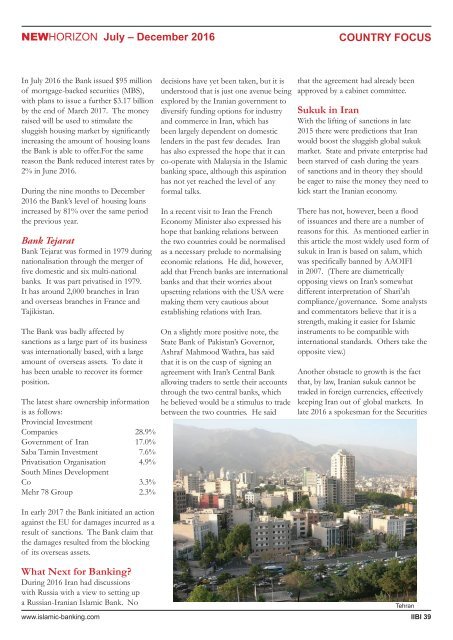NH-2016-q2
You also want an ePaper? Increase the reach of your titles
YUMPU automatically turns print PDFs into web optimized ePapers that Google loves.
NEWHORIZON July – December <strong>2016</strong><br />
COUNTRY FOCUS<br />
In July <strong>2016</strong> the Bank issued $95 million<br />
of mortgage-backed securities (MBS),<br />
with plans to issue a further $3.17 billion<br />
by the end of March 2017. The money<br />
raised will be used to stimulate the<br />
sluggish housing market by significantly<br />
increasing the amount of housing loans<br />
the Bank is able to offer.For the same<br />
reason the Bank reduced interest rates by<br />
2% in June <strong>2016</strong>.<br />
During the nine months to December<br />
<strong>2016</strong> the Bank’s level of housing loans<br />
increased by 81% over the same period<br />
the previous year.<br />
Bank Tejarat<br />
Bank Tejarat was formed in 1979 during<br />
nationalisation through the merger of<br />
five domestic and six multi-national<br />
banks. It was part privatised in 1979.<br />
It has around 2,000 branches in Iran<br />
and overseas branches in France and<br />
Tajikistan.<br />
The Bank was badly affected by<br />
sanctions as a large part of its business<br />
was internationally based, with a large<br />
amount of overseas assets. To date it<br />
has been unable to recover its former<br />
position.<br />
The latest share ownership information<br />
is as follows:<br />
Provincial Investment<br />
Companies 28.9%<br />
Government of Iran 17.0%<br />
Saba Tamin Investment 7.6%<br />
Privatisation Organisation 4.9%<br />
South Mines Development<br />
Co 3.3%<br />
Mehr 78 Group 2.3%<br />
In early 2017 the Bank initiated an action<br />
against the EU for damages incurred as a<br />
result of sanctions. The Bank claim that<br />
the damages resulted from the blocking<br />
of its overseas assets.<br />
What Next for Banking?<br />
During <strong>2016</strong> Iran had discussions<br />
with Russia with a view to setting up<br />
a Russian-Iranian Islamic Bank. No<br />
decisions have yet been taken, but it is<br />
understood that is just one avenue being<br />
explored by the Iranian government to<br />
diversify funding options for industry<br />
and commerce in Iran, which has<br />
been largely dependent on domestic<br />
lenders in the past few decades. Iran<br />
has also expressed the hope that it can<br />
co-operate with Malaysia in the Islamic<br />
banking space, although this aspiration<br />
has not yet reached the level of any<br />
formal talks.<br />
In a recent visit to Iran the French<br />
Economy Minister also expressed his<br />
hope that banking relations between<br />
the two countries could be normalised<br />
as a necessary prelude to normalising<br />
economic relations. He did, however,<br />
add that French banks are international<br />
banks and that their worries about<br />
upsetting relations with the USA were<br />
making them very cautious about<br />
establishing relations with Iran.<br />
On a slightly more positive note, the<br />
State Bank of Pakistan’s Governor,<br />
Ashraf Mahmood Wathra, has said<br />
that it is on the cusp of signing an<br />
agreement with Iran’s Central Bank<br />
allowing traders to settle their accounts<br />
through the two central banks, which<br />
he believed would be a stimulus to trade<br />
between the two countries. He said<br />
that the agreement had already been<br />
approved by a cabinet committee.<br />
Sukuk in Iran<br />
With the lifting of sanctions in late<br />
2015 there were predictions that Iran<br />
would boost the sluggish global sukuk<br />
market. State and private enterprise had<br />
been starved of cash during the years<br />
of sanctions and in theory they should<br />
be eager to raise the money they need to<br />
kick start the Iranian economy.<br />
There has not, however, been a flood<br />
of issuances and there are a number of<br />
reasons for this. As mentioned earlier in<br />
this article the most widely used form of<br />
sukuk in Iran is based on salam, which<br />
was specifically banned by AAOIFI<br />
in 2007. (There are diametrically<br />
opposing views on Iran’s somewhat<br />
different interpretation of Shari’ah<br />
compliance/governance. Some analysts<br />
and commentators believe that it is a<br />
strength, making it easier for Islamic<br />
instruments to be compatible with<br />
international standards. Others take the<br />
opposite view.)<br />
Another obstacle to growth is the fact<br />
that, by law, Iranian sukuk cannot be<br />
traded in foreign currencies, effectively<br />
keeping Iran out of global markets. In<br />
late <strong>2016</strong> a spokesman for the Securities<br />
Tehran<br />
www.islamic-banking.com IIBI 39


